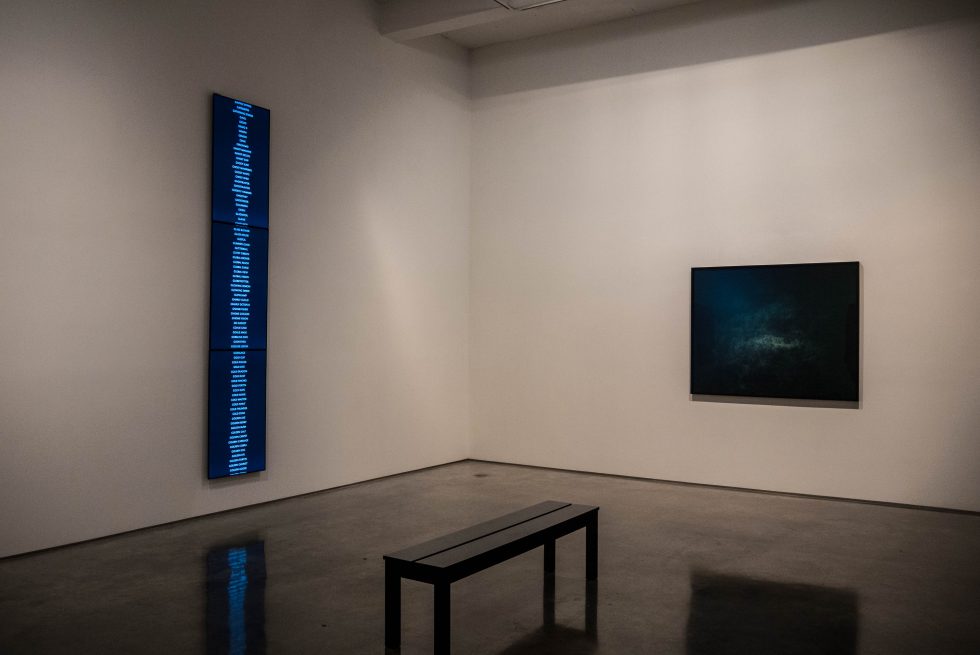
For the last 14 years, the US—and much of the rest of the world—has been engaged in a secret war. This is a profound change for a culture that grew up watching armed conflict in Vietnam, then Kuwait, and then the Balkans unfold during the evening news. Visualizing this secret war, the architecture of the surveillance state it depends upon, and the symbology of the people who wage it has been the theme of artist Trevor Paglen's work for some time now. A small overview of his work is currently on exhibit in New York, and Paglen recently gave the Clarice Smith Distinguished Lecture at the Smithsonian American Art Museum. We were on-hand at both to check them out.
Paglen has been documenting what he terms the "black" world—where projects and even their budgets are classified from public scrutiny—for quite some time. His 2007 book, I Could Tell You But Then You Would Have To Be Destroyed By Me, consisted largely of embroidered, real-life patches from secretive aerospace and intelligence-gathering projects, often having to do with the missions or statements of morale. Paglen became interested in the iconography of this secret culture while visiting the Antelope Valley in California, part of the empty Southwestern US that the secret world has chosen for its own.
Often unofficial, the patches are often nonetheless revealing. Projects based out of Groom Lake in Nevada—better known to some as Area 51—will often have a group of five stars kept company by another single star, for instance. A more obvious example is the Boeing Bird of Prey, a classified experimental aircraft built in the mid-1990s. When the project was declassified in 2002, it was suddenly apparent the plane's unconventional shape had been hiding in plain sight on the mission patch all along.
-
A U.S. Air Force Cyber Command patch. A bit on-the-nose, guys.Jonathan Gitlin
-
National Reconnaissance Office Launch-39 is a radar imaging spy satellite, launched into orbit from Vandenberg, CA, in December 2013.Jonathan Gitlin
-
Code Names Of The Surveillance State. It scrolls alphabetically through a list of 4,000 NSA and GCHQ code names. The original list compiled by Paglen stretched to over 15,000.Jonathan Gitlin
-
A big focus of Paglen's work has been the landscapes and architecture of the surveillance state. Beachscapes where cables make land are juxtaposed with charts covered in extracts from the Snowden files and elsewhere.Jonathan Gitlin
-
Another major cable lands on the east coast.Jonathan Gitlin
-
One day someone will conduct an extensive study on the culture of PowerPoint in the military and the intelligence world, and it's going to be fascinating.Jonathan Gitlin
-
Jonathan Gitlin
-
Jonathan Gitlin
-
Jonathan Gitlin
-
Lady Liberty is a symbol of freedom reaching into the sky. The windowless concrete tower is a telephone relay, now used as a means of surveillance and oppression.Jonathan Gitlin
-
A model of the USS Jimmy Carter, an extremely busy and very hush-hush boat that taps undersea cables (among other things).Jonathan Gitlin
-
The Autonomy Cube. A functional Tor relay to evade digital surveillance in an art gallery or museum.Jonathan Gitlin
-
We connected to the Autonomy Cube and works.Jonathan Gitlin
More recently, Paglen's work has involved photographic landscapes shot through astronomy-grade lenses: a series of long-exposure night skies with a single satellite conspicuously crossing the star field at an odd angle; or a remote desert air strip viewed from 30 miles away, the atmosphere distorting the image into abstraction. Beach scenes appear unremarkable, save for a cluster of white radomes in the distance—a clue that a major transatlantic cable lands nearby. Paglen even learned to scuba dive in the process, photographing the seaweed- and barnacle-encrusted cables themselves.
Paglen has also explored the use of language within the black world. Code Names of the Surveillance State is a scrolling list of 4,000 code names culled from the Snowden Files and elsewhere. It was first projected onto the UK's House of Commons at night, but now you can see it as a vertical display scrolling down the wall at Metro Pictures. These range from the humorous—I got a juvenile laugh out of CHOCOLATE STARFISH, and CHIGLEY GREEN might resonate with fans of the BBC's Trumpton series—to the nerdy (CHAOTIC STORMTROOPER, anyone) and the mysterious (CELESTIAL GOOSE?).
Filmmaker Laura Poitras eventually hired Paglen to shoot video landscapes of NSA and GCHQ surveillance listening posts for use in the documentary Citizenfour. One long sequence sees crows (or maybe ravens) enjoying the day in a pastoral setting, complete with hay bales in various states of construction. Behind them is Menwith Hill, a listening station for US satellites in the UK. Another watches the outskirts of the NSA's vast data center in Utah as it shimmers slightly in the telephoto lens.
It's not all photography and imagery. Paglen has also worked with Jacob Appelbaum to build the Autonomy Cube—at first glance, a lucite box with some electronics inside, but it's also a functional Tor relay. Museums or galleries are required to connect to the internet if they plan on showing it. Another project will create nonfunctional satellites covered in reflective mylar so they can be photographed from Earth.
The exhibit itself at Metro Pictures in Manhattan is not enormous, but it is worth your time to visit if you're in the area (it's showing until October 24).
reader comments
17